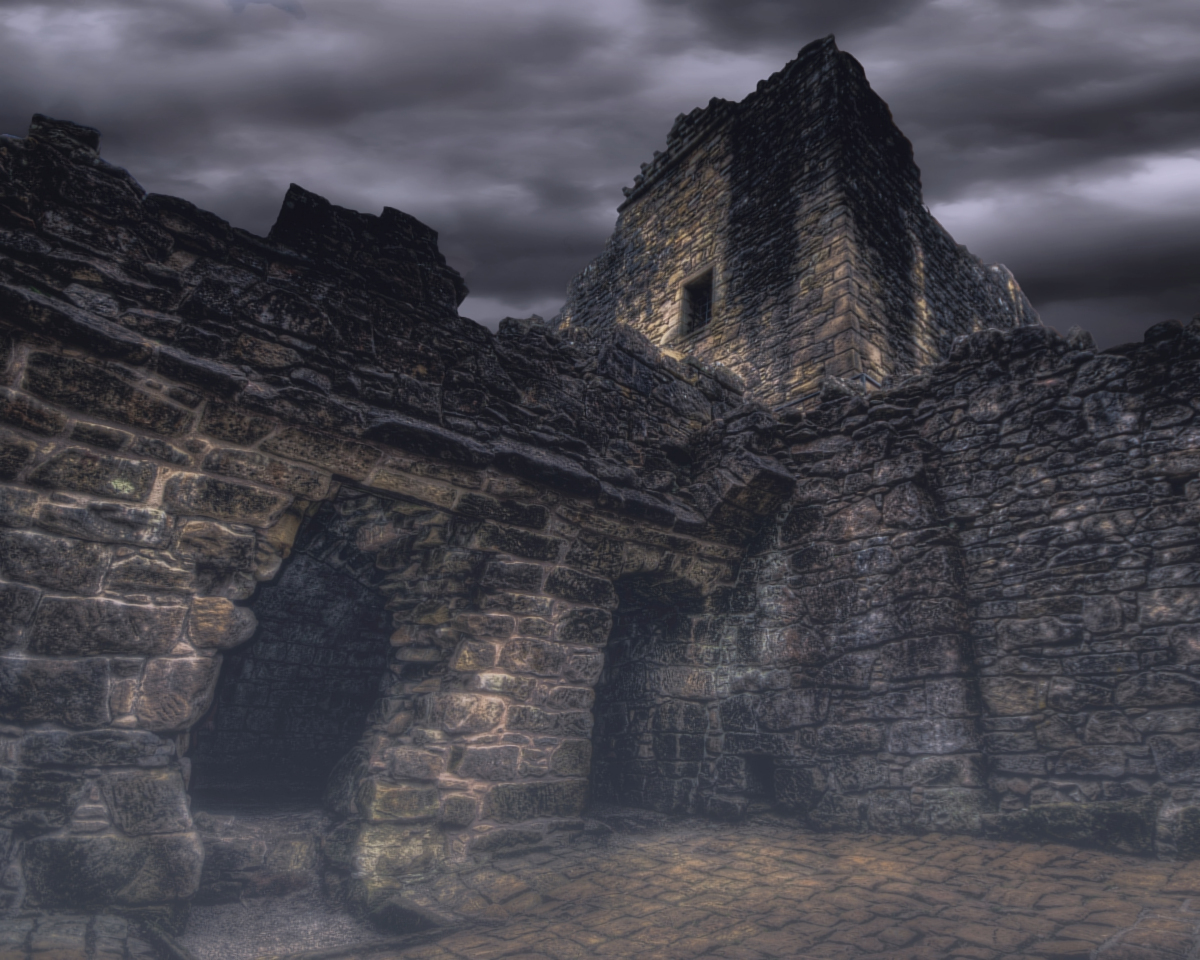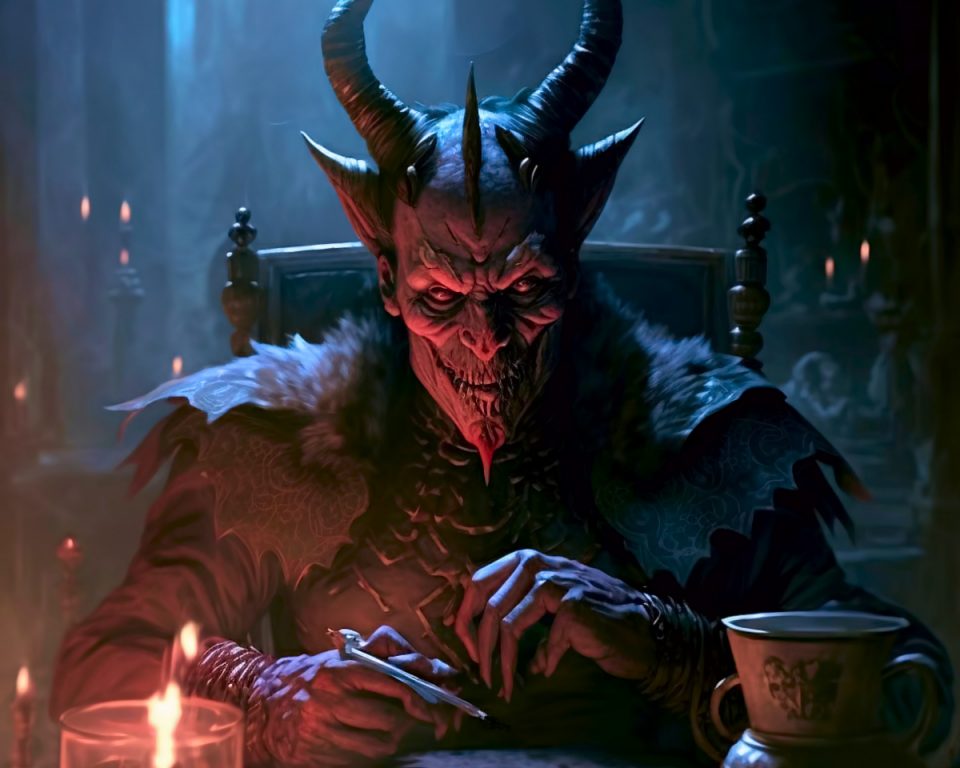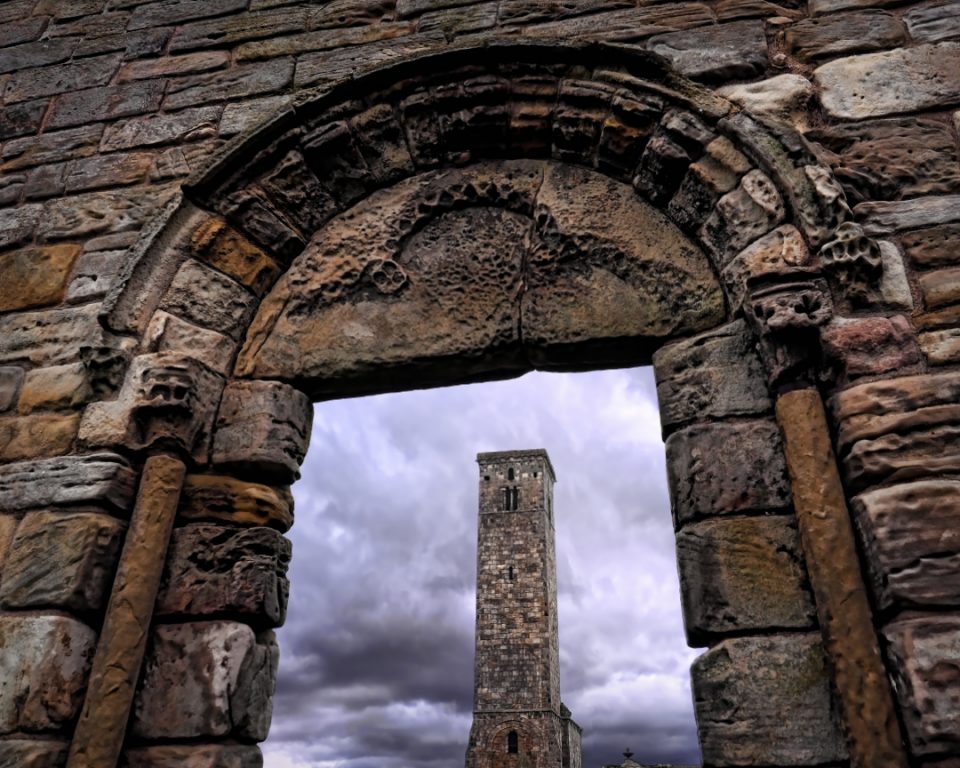Mary Queen of Scots took her first tentative steps down the stairway as the sun rose over Fotheringhay Castle sometime between 7 and 8 in the morning of the 8th of February 1587. But Mary was a queen, and she would meet her fate with the dignity of her office. A deadly hush would have descended as the Queen entered the Great Hall. The four hundred spectators must have jostled and vied to see the queen, once famed for her beauty.
These would be her last steps in a hostile land. A makeshift scaffold lay in front of her, complete with the executioner’s block. Mary had been sentenced to death by her cousin, Elizabeth I of England, a woman she had never met and whose throne she had once been heir to.
Mary Queen of Scots’ Execution
Her servants helped her to remove her black outer robes to reveal blood-red petticoats, the dress of a Catholic martyr. But for all her quiet demeanour, this was not an easy execution. It was only on the third swing of the axe that Mary’s head was finally removed. The axeman grasped her titian hair, only for her head to fall to the ground as it fell from its wig. Mary’s tumultuous life had taken its toll. Beneath the wig, her hair had turned to snow. It is said that her lips moved for about a quarter of an hour after her death.
It was then that a horrific discovery was made. Cowering beneath her petticoats was Mary’s dog, a little Skye Terrier. The dog refused to leave her side and had to be forcibly removed. The poor creature refused to eat and pining for its mistress, died soon after. Perhaps, in all the world, this was the only creature who truly loved Mary for who she was rather than for what she represented.
Mary Stewart’s Tragic Life
Mary Queen of Scots was a mere 44 years old at the time of her death. However, her short life was tragic. Ill-fated in love, used and betrayed by those closest to her, raped and her infant child torn from her breast, Mary’s life was certainly not a princess fairy tale.
Mary’s troubles began when her father died after the Scottish defeat at the Battle of Solway Moss. Mary was six days old. She was immediately proclaimed queen and plunged into a cauldron of political turmoil containing a broiling mix of the long-standing enmity between Scotland and England, the fragility of the Tudor succession to the English throne, England’s rivalry with France, and the religious violence between Catholics and Protestants. The Kings of England and France gleefully rubbed their hands at the prospect of expanding their kingdoms at Mary’s expense.
Mary Of Guise
James V had scarcely been laid to rest when Henry VIII declared his intentions of marrying the infant Mary to his son Edward, as a means of controlling Scotland. This prospect was unpalatable to Mary’s French mother, Mary of Guise, who was acting as queen regent at the time. Along with her brothers, she hatched up a plan which would elevate the Guise family in the French court. At five years of age, Mary Stewart was shipped off to France to be brought up as the future wife of the dauphin, Francis, son of the French king, Henri II. She had a brief rule as the Consort Queen of France with her sickly husband delegating his power to the Guise brothers.
Mary Queen of Scots’ Return to Scotland
Scotland was a whisper-breath away from coming under French control. This was the height of the Scottish Reformation and amongst the now mainly Presbyterian population, there was a growing fear that Scotland would become a Catholic province of France. Perhaps the fear was justified. Many Protestants lost their lives at the beginning of the Reformation including the martyrs Patrick Hamilton and George Wishart who met their deaths at St Andrews.
However, Francis died aged 16 and Scotland slipped out of France’s grasp. The widowed Mary was no longer wanted in France, so she returned to Scotland with the intention of ruling her home country.
James Stewart, Earl of Moray
Scotland was a far cry from the genteel French court. The Scottish court was a male-dominated world of austere Presbyterian advisors. Amongst Mary’s advisors was her half-brother James Stewart, the Earl of Moray. Moray appeared to be her strongest ally. He had accompanied her to France when she was five, had been her long-term advisor and had encouraged her to return to Scotland when she was first widowed. But he had ulterior motives. He wanted power for himself. Unfortunately, he was the illegitimate son of James V and his mistress, Lady Margaret Erskine. As such, he had no claim to the throne.
But he saw a way of grasping the power. Mary would be a figurehead ruler, while he would be the real power behind the throne. Only his sister turned out to be more formidable than he imagined. She had been raised to be a queen and a queen she would be. Thus, Moray began working away in the background, chipping away at her authority, and repeatedly attempting to unseat her.
The 18-year-old queen showed promise as a monarch. She encouraged religious toleration, engaged advisors from all the major clans and listened to their counsel, even when they were working against her. Then there was the inevitable interference from the English Monarchy regarding her marriage plans.
Marriage to Henry, Lord Darnley
Elizabeth I offered Robert Dudley, Earl of Leicester to Mary as a husband. The Scottish queen baulked at the idea. Dudley was a traitor’s son, rumoured to be Elizabeth’s lover, and if the gossip was true, he was involved in the suspicious death of his own wife. If all that was not bad enough, Elizabeth had the audacity to want all three of them to live at her court together. Naturally, Mary refused. If her options in life had become narrow, she still had control over whom she would marry.
Her choice of husband turned out to be disastrous. She decided to marry her relative Henry, Lord Darnley. He was handsome, young, possessed royal blood and he was Catholic. But Darnley was also weak, corrupt and a drunkard. Things began to unravel soon after their marriage in 1565. Darnley had wed Mary with the intention of being the ruling king rather than Mary’s consort. Mary resisted. He fell out with all the lords, including the Earl of Moray.
Mary Queen of Scots’ Marriage begins to Fail
By early 1566 relations between Mary and Lord Darnley were becoming very fraught. Darnley’s character flaws were becoming more and more obvious to all: he was a narcissist, a drunkard, a natural conspirator and was promiscuous. Mary was prepared to govern Scotland with her husband as equals but Darnley ‘expected her to cede all her power as reigning queen to him’ and believed that she was ‘his subordinate’.
As Mary and Darnley’s relationship deteriorated, Mary’s secretary David Rizzio grew in her favour. In turn, Darnley was known to be increasingly jealous of the closeness between Mary and the Italian. Meanwhile, a group of those waiting to be tried for treason played on Darnley’s jealousy, convincing him that he was being cuckolded by the Italian. Egotistical and inexperienced, Darnley was like putty in the hands of the ruthless, power-hungry men who were closing in on him. He would become their most powerful weapon. The conspirators entered into a written bond with Darnley, for what amounted to a coup against Mary. Under its terms Rizzio would be murdered; Darnley would be crowned king rather than just consort; the outlawed lords would be pardoned, those exiled to England allowed to return; and Mary’s power would be greatly reduced.
Rizzio’s Murder
On the evening of Saturday 9 March 1566, Mary, at the time six months pregnant with the future King James VI, was having dinner at Holyrood Palace with a small group including Rizzio. Five lords burst into the chamber. Rizzio was hauled out of the room, and at the top of a nearby staircase was stabbed 57 times, with Lord Darnley’s dagger being left in his body. His body was stripped of its jewels and clothing, then thrown down the stairs.
It would have been easier for the conspirators to achieve their objective away from Edinburgh and there were ample opportunities to do so. It seems that their main aim was to cause the Queen to miscarry through pure shock. With the backward medical practices of the time, a mid-term miscarriage invariably led to the mother’s death. Unbeknown to Darnley, the conspirators would never have allowed him to take the throne. Rather he would have become the scapegoat for this treasonable plot while Moray would have swept to power. However, Mary was stronger than they gave her credit for.
A Failed Plan
The rest of the plan failed. Mary knew her life was under threat. She took advantage of Lord Darnley’s weakness by offering him forgiveness if he helped her escape from Holyrood Palace. Darnley helped her ride to safety at Dunbar Castle. Here they were met by James Hepburn, 4th Earl of Bothwell, with an army of 4,000. Mary subsequently used these troops to hunt down those involved in the coup.
The Earl of Bothwell
Mary saw James Hepburn, 1st Duke of Orkney and 4th Earl of Bothwell, as a friend. He had befriended her while she was in France, visiting in his capacity as Lord High Admiral, and helped to organise her return back to Scotland when she was 18. However, it was his role in helping Mary escape after Rizzio’s murder which truly won him Mary’s favour.
Bothwell was not shy in using this to his advantage. A year later Darnley’s residence at Kirk o’ Fields was blown up, killing Mary’s husband. The most likely perpetrator was Bothwell for less than three months after the death of Darnley in February 1567, Bothwell ambushed Mary while she was travelling and told her she must come with him, as there was rioting in Edinburgh. Naturally, she trusted him and agreed to go with him.
Mary Queen of Scots’ Marriage Number Three
Bothwell carried Mary back to his castle, Dunbar, where he raped her. His plan was that she would marry him– most young women at the time, particularly heiresses, were expected to wed their assaulters. Mary, believing that she was pregnant did exactly that.
Bothwell wasn’t the only Lord involved in Darnley’s death. Moray and his allies were in on the plot. When the deed was finally done, Moray cunningly deflected the blame on to Mary, encouraging her to leave the investigation to the council of lords that had been appointed to advise her. Meanwhile, the council did little to find the murderers.
Mary’s luck was running out. So unpopular was her marriage to Bothwell that it gave Moray the opportunity to gather around him an array of Scottish lords. Twenty-six Scottish peers, known as the confederate lords, turned against Mary and Bothwell and raised an army. Mary and Bothwell confronted the lords at Carberry Hill on 15 June 1567, but there was no battle, as Mary’s forces deserted during the negotiations. Bothwell was given safe passage from the field. The lords took Mary to Edinburgh, where crowds of spectators denounced her as a murderer and an adulteress. It seemed that even her subjects had turned against her.
Imprisonment of Mary Queen of Scots at Lochleven Castle
The following night, she was imprisoned in the isolated Lochleven Castle. Sometime between 20 and 23 July, Mary miscarried twins. Then on 24 July, Moray visited the weakened queen and coldly told her that she must abdicate in favour of her one-year-old son James. Moray finally had his wish and was made regent, while Bothwell was driven into exile.
It seems that there is such a thing as Karma. Both men had their lives cut short. Moray was shot in Linlithgow in 1570 while Bothwell was captured at sea by the King of Denmark who imprisoned him. Bothwell became insane and died in 1578.
Mary Queen of Scots’ escape from Lochleven.
On 2 May 1568, Mary escaped from Lochleven Castle with the aid of George Douglas, brother of the castle’s owner, Sir William Douglas. She was subsequently defeated by Moray’s smaller army at the Battle of Langside on 13 May. Mary then made the biggest mistake of her life. She fled to England, convinced that Elizabeth I would help her return to power.
However, Elizabeth’s chief minister, William Cecil had always hated Mary and wanted her off the throne. Mary was simply too Catholic for his tastes. All along he had been pulling strings in the background. Most of the lords in Scotland and most notably Moray, were in Cecil’s pocket, paid to undermine Mary and hopefully remove her. Whether Cecil knew about their coup attempts or not, his funds certainly assisted them.
Mary Queen of Scots in Captivity
So, when Mary fled into England, Cecil pushed hard for Mary to be submitted to an inquiry for involvement in the death of Darnley. The real aim was not to find her guilty or innocent, but to create a non-verdict ensuring that she would continue to languish in prison. Elizabeth’s ministers were able to play on her jealousy for the Scottish queen. Mary was said to be a great beauty while Elizabeth had been left scarred from a bout of smallpox. For the next nineteen years, Mary was to spend her life under lock and key in a variety of English Castles. They were carefully chosen to be in isolated places far from both the Scottish border and the English capital.
In reality what Cecil, and other ministers such as Francis Walsingham wanted, was an excuse to get rid of Mary. They hired a double agent, who volunteered to take her letters to France. Every letter was opened and decoded. When, finally, after nearly 20 years of imprisonment, Mary agreed to conspire in a plot against her cousin, Cecil had the evidence he needed to execute her.
The End of a Dream
After 19 years in prison, Mary had lost everything she once held precious. Her dream of a Catholic empire was lost. She had lost power in France and in Scotland. Her liberty was gone, and she hadn’t seen her son since he was a baby. Isolated with no hope of release or escape, Mary had become desperate.
Elizabeth’s ministers demanded Mary’s execution, and making reference to Mary’s Catholic following stated ‘so long as there is life in her, there is hope; so as they live in hope, we live in fear’. Thus, Mary earned her place in the history books as Scotland’s most famous queen. If she was a haunting presence in life, in death she was to become Scotland’s most ubiquitous ghost. There is scarcely a castle or stately house in Scotland which is not said to be haunted by Mary Queen of Scots. Then there are the castles in England where she was held captive.
Stirling Castle
Mary made frequent visits to Stirling Castle, one of Scotland’s greatest strongholds and which was recovered from the English, by Robert the Bruce at the Battle of Bannockburn. Sitting on top of a plug of volcanic rock, this was one of the most strategically placed castles in Scotland. It was here that Mary sent her son James to be brought up.
However, despite its defensive position, it seems that Stirling Castle is not impenetrable to visitors from the Other Realm. A ghost seen at the castle is the “Pink Lady.” The phantom of a beautiful girl wearing a pink silk gown is thought to be that of the Queen. However, in another story it is said that this is the spectre of a woman who lost her husband in the siege of 1304 and is still looking for him.
Another apparition called the “Green Lady” is reputed to be a servant who rescued her mistress, Mary Queen of Scots after a bedside candle set fire to her sheets.
Hermitage Castle
An apparition of Mary has been seen at Hermitage Castle despite her only having visited it for a few hours during her lifetime. On the 8th October 1566, Bothwell got into a fight with his neighbours, the Elliots. Apparently, Little Jock Elliot of Park stabbed Bothwell. Meanwhile, Elliot was shot during the fray and died of his injuries. Bothwell returned to Hermitage Castle to recover.
Mary Queen of Scots was in Jedburgh at the time and hurried to Hermitage on October 16th to tend to Bothwell. Mary only spent a couple of hours there, being a married woman, and left to return on that same day to what is now known as Mary Queen of Scots House in Jedburgh. This building is also purported to be haunted by the queen.
Doune Castle
Doune Castle was built by Robert Stewart, Duke of Albany and brother to the infamous Wolf of Badenoch. Mary stayed here on several occasions, occupying the suite of rooms above the kitchen. Doune was held by forces loyal to Mary during the brief civil war which followed her forced abdication in 1567. Alas, the garrison was forced to surrender to the Regent, Matthew Stewart, 4th Earl of Lennox, in 1570, after a three-day siege. Apparitions of Mary have been seen here.
Ghostly Horses at Houndwood House
Mary was said to have visited Houndwood House in the Scottish Borders. One of her rings was found in the house grounds. The sounds of ghostly horses herald the phantom Mary’s arrival.
The Covenanter Hotel in Falkland
One of Mary Queen of Scots’ favourite haunts during her mortal life was Falkland Palace. Mary was enchanted with the palace and took advantage of Falkland’s vast estate to pursue falconry and hunting. She also enjoying a game of tennis in what is now the oldest surviving real (or royal) tennis court in the world.
It is small wonder that in death her spirit is still said to return to the area. However, her apparition is most likely to appear at the Covenanter Hotel in Falkirk which is located next to the palace. The hotel was built in 1771 so perhaps another building stood where the Hotel is now located.
Borthwick Castle
Borthwick Castle is located in Gorebridge near Edinburgh. In 1567 Mary took refuge in Borthwick Castle. However, 1000 men surrounded the castle. Mary was forced to sneak out of a window dressed as a pageboy. Although she managed to escape the castle that day in body, many say that Mary’s spirit wanders back from time to time.
Lochleven Castle
Lochleven Castle is another stronghold that Mary is said to haunt. It was here that Mary was first imprisoned by her brother, Moray and it was here that she was forced to abdicate in favour of her son. Mary managed to escape from here in 1568 but her freedom was short-lived. Her spirit is said to have lingered, long after another great escape.
Mary Queen of Scots’ Headless ghost at Craignethan Castle
Mary sought refuge at Craignethan Castle near Lanark after her escape from Loch Leven. It is also said to be another favourite haunt of the ghostly Mary. She stayed there overnight before the Battle of Langside, but nevertheless, it is said her headless ghost began appearing there, after her execution.
Mary Queen of Scots Haunts a series of English Castles
After Mary’s capture in England, she was held in a succession of castles which the erstwhile queen is now said to haunt. First, there was Carlisle castle and then Bolton castle, where she is said to haunt the courtyard. At Nappa Hall, she is allegedly wearing a black velvet dress.
After being placed into the custody of the Earl of Shrewsbury, she was held in three of his castles. In the 1930s her ghost reported to have been seen walking through the walls of the at the Turret House of the Earl’s Manor Lodge in Sheffield.
Mary’s son James had Fotheringhay Castle razed to the ground after his ascension to the English throne. Little remains of the place where Mary died. However, some of the stone and the oak staircase, which she walked down to face her execution, were used to build the nearby Talbot Hotel in Oundle. Mary’s apparition is said to be a regular guest.
Linlithgow Palace
Perhaps surprisingly, there is one historic building in Scotland that is notable by its lack of a ghost of Mary, Queen of Scots. Her birthplace, Linlithgow Palace, does, however, boast the spectres of her mother, Mary of Guise and her grandmother Margaret Tudor. Mary became heir to the English throne through her descend from Margaret Tudor.
Holyrood Palace
Perhaps the Castle which is most famously associated with Mary Queen of Scots is Holyrood Palace. Here the wraith of the murdered David Rizzio is said to walk it halls. To this day, the bloodstain remains on the wooden floor where he was murdered, outside Mary’s private quarters. According to Palace staff, these floorboards have been replaced several times. However, Rizzio’s bloodstains always reappear in the same place. A ghostly figure has been seen in this area and unexplained noises heard late at night.
Meanwhile, wailing can sometimes be heard coming from the basement. This is thought to be the ghost of Agnes Sampson who was brutally tortured under the express command of Mary’s son, James VI during the Scottish witch trials.
In life, Mary experienced a hauntingly tragic existence. In death, her presence is even more haunting!
Please feel free to share the spooky by using the links below or leave us a message in the comments box.




